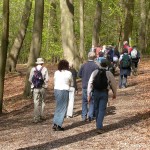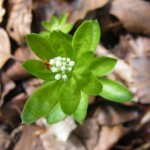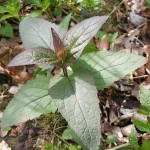Michael Keith-Lucas led a walk in Bisham Woods on Sunday 25th April. The woods, which lie on a steep slope overlooking the River Thames near Marlow, are ancient mixed woodland with a rich ground flora. One of the local specialities is Small-leaved Lime, Tilia cordata, with characteristic soft, heart-shaped leaves. It took some time for the group to move off, because there were so many ancient woodland indicator species growing close to the car park. These included both Common and Early Dog-violet, Wood Anemone, Solomon’s Seal, Bluebell, Primrose, Wood Spurge and Enchanter’s Nightshade. The Dog’s Mercury plants in a sunny position at the side of the ride were all identified as males. The female plants prefer shadier conditions and were duly located later in a more suitable position.
Prompted by the sight of a beech seedling, Michael outlined some of the problems currently being faced by Chiltern beech trees. With milder winters, the trees are producing pollen at earlier dates, but a single degree of frost is sufficient to destroy a season’s pollen production. As a result, in 4 out of 5 years, no viable beech mast is produced. Beech seedlings need shade, and the best conditions for growing young beeches are with a conifer nurse crop. However, in some quarters, the planting of conifers is considered to be inappropriate for the Chilterns. The most suitable conditions for beeches are on the clay-with-flints, above the chalk. Many of the older beeches were planted on the less-suitable steep chalk slopes. Being a shallow-rooted species, they are particularly vulnerable to droughts or strong winds. Many beech trees in the steepest part of the wood were felled in the great storm of 1987. Large numbers of ash trees and a few larches have grown up in the area of storm damage.
Michael pointed out that the woodland evergreens such as ivy, holly and yew are Atlantic species which decrease in abundance as one moves eastwards across Europe. Other ancient woodland indicator species encountered on the walk included Woodruff, Twayblade, the wasp-pollinated Common Figwort, Sanicle, Yellow Archangel, Wild Cherry and Common Whitebeam. Several Orange Ladybirds were seen. A round, smooth, dense pebble was identified as coming from the Bunter Beds in the Midlands.
Pictures by Rob Stallard and Jan Haseler
RDNHS Walk 25 April 2010 Bisham Wood
Fagus sylvatica Beech
Fraxinus excelsior Ash
Corylus avellana Hazel
Mercurialis perennis Dog’s-mercury
Polygonatum multiflorum Solomon’s-seal
Hyacinthoides non-scripta Bluebell
Arum maculatum Lords-and-Ladies
Anemone nemorosa Wood Anemone
Primula vulgaris Primrose
Viola reichenbachiana Early dog-violet
Euphorbia amygdaloides Wood-spurge
Veronica montana Wood Speedwell
Ajuga reptans Bugle
Geum urbanum Wood Avens
Circea lutetiana Enchanter’s-nightshade
Lysimachia nemorum Yellow Pimpernel
Melica uniflora Wood Melick
Ranunculus ficaria Lesser Celandine
Brachypodium sylvaticum False-brome
Cerex remota Remote sedge
Tilia cordata Small-leaved Lime
Hypericum androsaemum Tutsan
Ligustrum vulgare Wild Privet
Geranium robertianum Herb-Robert
Acer campestre Field Maple
Cornus sanguinea Dogwood
Hypericum hirsutum Hairy St John’s-wort
Hypericum pulchrum Slender St John’s-wort
Sanicula europaea Sanicle
Listera ovata Twayblade
Galium odoratum Woodruff
Hedera helix Ivy
Ilex aquifolium Holly
Taxus baccata Yew
Sorbus aria Common Whitebeam
Ribes rubrum Red Currant
Lamiastrum galeobdolo Yellow Archangel
list compiled by Janet Welsh




